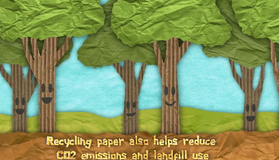How it’smade, bio-diesel
Bio-diesel is more eco-friendly diesel fuel that’smade from vegetable oil or animal fat. Unlike regular diesel and gasoline, producing bio-diesel doesn’t require petroleum. Instead the raw materials arelocally available and can be recycled from waste. If your car has a dieselengine, it can run on bio-diesel fuel, usually without requiring any modifications. While bio-diesel and petroleum diesel are similar in energyefficiency and fuel economy, bio-diesel is more eco-friendly.

For starters it can be made from what would otherwise have been waste, for example, fromvegetable oil of your local fast food joint. The restaurant simply discards itsused fry oil in a receptacle out back. Every few days, a vacuum truck comes byto collect it. In its current state, the oil contains water and food particles,making it unusable for bio-diesel production. So the truck transports it to afiltering plant. There, they pumped the oil into a holding tank. Then heat itup to dry out the water. Once they drain the water, the oil is ready to enter amulti-stage filtering process. First the oil goes through a vibrating sieve,which stains out the larger pieces of debris. After this first filtering, theoil is already visibly cleaner. Next, it passes through a second vibratingsieve. This one has a finer mesh. Therefore it catches smaller particles ofdebris. After the second stage, the oil looks clean, but still containsmicroscopic debris. So it enters the third and final filtering stage—passingthrough 20 ultra fine filter cloths, which trap any particles larger than onemicron in size. A micron is about 80 times smaller than the width of a humanhair. The captured debris loses a muddy residue on the filters. That vegetableoil which went deep fried potatoes, is now ready to cook up some diesel fuel.
Another source of oil for making bio-diesel is beeftallow. Oil derived from cow fat. Bio-diesel producers typically buy tallowfrom facilities like this one, which specializes in cleaning cow hides for leathertanneries. Sharp revolving blades shear off the fat from the back of the hide. Thefat drops on to a conveyor, which moves it into a steam injection cook tank. Thetank heats the fat to a gentle boil extracting the oil. Everything else leavesthe tank, and drops into a waste container. The oil moves onward, passingthrough a two stage filtration process.
Whether the raw material is vegetable oil or beeftallow, the bio-diesel producers refer to this main ingredient as feedstock. Whenthe feedstock arrives at the bio-diesel plant, it goes into a holding tankuntil production time. This demonstration illustrates the production recipe. Theytake the feedstock, and combine it with methanol, a type of wood alcohol, aswell as with the catalyst, which triggers the chemical reaction. A processingunit mixes everything thoroughly while applying heat and pressure. Theresulting chemical reaction produces a harmless byproduct glycerin, a commoningredient in soaps and cosmetics. Processing consumes much of the methanol. Thenthey remove even more, leaving just a tiny percentage of it in the finishedbio-diesel. To ensure their fuel, meets international regulatory standards, theplants quality control lab tests samples from each production run. In thisflammability test, they heat the fuel to 135℃,and apply a flame to see whether the gas is ignited. If they do, they have tomove more methanol to make the fuel safe. It they don’t ignite, the fuel meetinternational safety standards. Bio-diesel costs more at the pump, but it meanssignificantly less carbon dioxide and monoxide, and 85% fewer cancer causingagents into the air we breathe.


